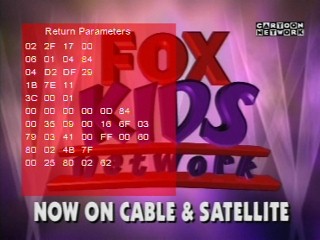- a START command
- a STOP command
- Status select command
after which the diagnostics data is put on screen. Leave the menu by pressing LEFT on the remote which will bring you back in the main menu.
In order to scan for new channels without having a frequency list with Symbol Rates and FEC figures at hand, the Status Select command comes in rather handy. Here's how to use it and interpretate the displayed data :
- Assuming the internal menu is allready up by the time you are reading this (otherwise press RADIO-99-RADIO-MARK), press 8 (select frequency integer) and enter the frequency. Since the receiver sometimes makes mistakes, it is best to enter the IF frequency directly.
- Set the symbolrate to 0.
- Set the aquisition bandwidth to the assumed bandwidth of the signal, so 40MHz fo packages and 8MHz for SCPC signals.
- Press LEFT to get back to the menu and call the QPSK menu by pressing 5.
- Use arrow UP/DOWN to get to 'select QPSK Status'.
- Now start pressing OK several times until the fourth row with HEX digits counted from the top changes from 00 80 00 into any other figures. If the display sticks to 00 80 00 (no signal), it can mean that either the entered frequency is wrong or the aquisition bandwidth has been set too narrow when receiving a package or too wide when attempting to receive SCPC signals. A little patience is required ...
Now here's what the numbers actually mean :

The 3rd digit on the 2nd row indicates the FEC used. In this example, it is set to 04 which means a FEC of 3/4 is in use.
- 02 = 1/2
- 03 = 2/3
- 04 = 3/4
- 06 = 5/6
- 07 = 7/8
The fourth row only displays 3 hex bytes. The first byte (1B) is the symbol rate integer, in this example 27 (1Bh = 27 decimal), followed by the SR fraction (7E 11). Remember this fraction and enter it in submenu 8. Go back to the QPSK status menu and compare the results with the numbers you kept in mind. You have to repeat this procedure a couple of times until you find a match or get close to a match. Here's a rough scale for the fractions :
- .100 > 1999
- .200 > 3333
- .300 > 4CCC
- .400 > 6666
- .500 > 8000
- .600 > 9999
- .700 > B333
- .800 > CCCC
- .900 > E666
In this example, the fraction is 7E 11 which is close to 500. The symbol rate therefore would be 27.500 which matches the channel displayed.
If only the first 2 bytes on row 4 change after you pressed OK a coupe of times, it can mean :
- The receiver is unable to lock to the system but is in fact measuring the bandwidth. This happens for MPEG1.5 as well as EBU system CCR723.
- You are tuned in to 'complicated' system like some PowerVu / NTL and C-band transmissions. In this case you should start to experiment with the aquisition bandwidth.
- The signal is too weak.
The other possibility is that only the second byte on row four changes. This means you are getting close to a signal. In order to get it in, you should change either frequency or bandwidth in submenu 8. Makes you wonder why the receiver can not take care of it itself ...
In order to make the receiver lock to narrow signals, there are 2 procedures you can follow :
- Set the aquisition bandwidth to either 0 or 1MHz. The disadvantage being that the entered frequency has to be almost spot on.
- After you have entered frequency and symbol rate, go back to the main menu (display now shows 'deb') and press PgDn a couple of times. The OSD now starts to flicker and shows the sign 'no text'. Be a little patient, after a couple of seconds the receiver should now lock into the signal.